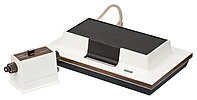Wikipedia:Today's featured article/requests/Magnavox Odyssey: Difference between revisions
→Magnavox Odyssey: Fixing dates |
No edit summary |
||
| Line 10: | Line 10: | ||
<div style="width: 55%; background-color: #f5fffa; border: 1px solid #cef2e0; margin-bottom: 1em; padding: 0.5em 1em 1em; color: black;"> |
<div style="width: 55%; background-color: #f5fffa; border: 1px solid #cef2e0; margin-bottom: 1em; padding: 0.5em 1em 1em; color: black;"> |
||
{{Main page image/TFA|Magnavox-Odyssey-Console-Set.jpg|title=Magnavox Odyssey}} |
{{Main page image/TFA|Magnavox-Odyssey-Console-Set.jpg|title=Magnavox Odyssey}} |
||
The '''[[Magnavox Odyssey]]''' is the first commercial [[home video game console]]. It consists of a white, black, and brown box that connects to a television set, and two [[game controller|controllers]] attached by wires. It can display three square dots and one line on the screen in [[monochrome]] black and white; players place plastic overlays on the screen to display additional visual elements. [[Ralph H. Baer]] conceived the console in August 1966 and his team |
The '''[[Magnavox Odyssey]]''' is the first commercial [[home video game console]]. It consists of a white, black, and brown box that connects to a television set, and two [[game controller|controllers]] attached by wires. It can display three square dots and one line on the screen in [[monochrome]] black and white; players place plastic overlays on the screen to display additional visual elements. [[Ralph H. Baer]] conceived the console in August 1966 and his team at [[Sanders Associates]] developed it. [[Magnavox]] agreed to produce it in January 1971 and released it in September 1972, selling 69,000 units in its first [[calendar year]] and 350,000 by its discontinuation in 1975. Patents by Baer and the other developers for the system and the games formed the basis of a series of lawsuits spanning 20 years, earning Magnavox and other developers over US$100 million. The release of the Odyssey marked the beginning of the [[first generation of video game consoles]] and spawned the [[Odyssey series]] of [[dedicated console]]s, as well as the 1978 [[Magnavox Odyssey 2]]. {{TFAFULL|Magnavox Odyssey}} |
||
</div> |
</div> |
||
* [[Wikipedia:Today's featured article/recent TFAs|Most recent similar article(s)]]: [[Wipeout 2048]], a video game, is scheduled for Aug. 12. The last computer/gaming hardware featured was [[Power Mac G4 Cube]] on January 9. |
* [[Wikipedia:Today's featured article/recent TFAs|Most recent similar article(s)]]: [[Wipeout 2048]], a video game, is scheduled for Aug. 12. The last computer/gaming hardware featured was [[Power Mac G4 Cube]] on January 9. |
||
Revision as of 18:51, 15 July 2022
Magnavox Odyssey
The Magnavox Odyssey is the first commercial home video game console. It consists of a white, black, and brown box that connects to a television set, and two controllers attached by wires. It can display three square dots and one line on the screen in monochrome black and white; players place plastic overlays on the screen to display additional visual elements. Ralph H. Baer conceived the console in August 1966 and his team at Sanders Associates developed it. Magnavox agreed to produce it in January 1971 and released it in September 1972, selling 69,000 units in its first calendar year and 350,000 by its discontinuation in 1975. Patents by Baer and the other developers for the system and the games formed the basis of a series of lawsuits spanning 20 years, earning Magnavox and other developers over US$100 million. The release of the Odyssey marked the beginning of the first generation of video game consoles and spawned the Odyssey series of dedicated consoles, as well as the 1978 Magnavox Odyssey 2. (Full article...)
- Most recent similar article(s): Wipeout 2048, a video game, is scheduled for Aug. 12. The last computer/gaming hardware featured was Power Mac G4 Cube on January 9.
- Main editors: PresN
- Promoted: 18 October 2020
- Reasons for nomination: September is the 50th anniversary of its release, although an exact date is not given in the article. A blurb was not written on the talk page, so I wrote one using the lede.
- Support as nominator. Z1720 (talk) 16:44, 15 July 2022 (UTC)

